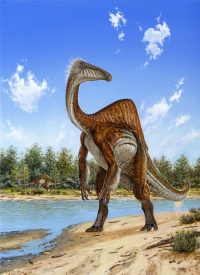"Nearly 50 years ago, scientists found bones of two large, powerful dinosaur arms in Mongolia and figured they had discovered a fearsome critter with killer claws. Now scientists have found the rest of the dinosaur and have new descriptions for it: goofy and weird. The beast probably lumbered along on two legs like a cross between TV dinosaur Barney and Jar Jar Binks of "Star Wars" fame. It was 16 feet tall and 36 feet long, weighing 7 tons, with a duckbill on its head and a hump-like sail on its back. It had killer claws, tufts of feathers here and there, and no teeth. And if that's not enough, it ate like a giant vacuum cleaner. That's Deinocheirus mirificus (DY'-noh'-KY-ruhs mur-IHF'-ee-kuhs), which means "terrible hands that look peculiar." It is newly reimagined after a full skeleton was found in Mongolia and described in a paper released Wednesday (Oct. 22) by the journal Nature. (NBC News)
Nature
"Fossils of Deinocheirus mirificus — a pastiche of Greek and Latin meaning 'unusual horrible hand' — were first unearthed in the summer of 1965 in the Gobi Desert in southern Mongolia. Along with a few rib and vertebra fragments, the remains included a remarkable set of shoulder girdles and 2.4-metre-long forelimbs, the longest yet found for a bipedal animal of any era (although some flying animals, notably pterosaurs, had longer wings).
Nature
"Fossils of Deinocheirus mirificus — a pastiche of Greek and Latin meaning 'unusual horrible hand' — were first unearthed in the summer of 1965 in the Gobi Desert in southern Mongolia. Along with a few rib and vertebra fragments, the remains included a remarkable set of shoulder girdles and 2.4-metre-long forelimbs, the longest yet found for a bipedal animal of any era (although some flying animals, notably pterosaurs, had longer wings).
Eventually, scientists placed Deinocheirus in a subgroup of theropod dinosaurs known as ornithomimosaurs ('bird-mimicking lizards') — which makes them relatively close kin to fierce predators such as T. rex and Allosaurus, says Yuong-Nam Lee, a vertebrate palaeontologist at the Korea Institute of Geoscience and Mineral Resources in Daejeon, South Korea, and a co-author of the study.
Near-complete skeleton
In expeditions to the Gobi Desert in the past decade, Lee and his colleagues have unearthed the 70-million-year-old fossils of two more individuals of the species from sites near to where the original 1965 specimen was discovered. Together, those remains — along with some bones stolen by poachers before Lee and his team found the fossils, but since recovered from a private collection — account for about 95% of the creature’s skeleton, he notes.
The newer-found bones differ from those of other ornithomimosaurs in several unexpected ways. Most of the spinal vertebrae have blade-like projections that extended upward and served as anchors for a network of ligaments that probably helped to support the immense weight of the creature’s abdomen. The researchers estimate that Deinocheirus was about 11 metres long and tipped the scales at more than 6.3 tonnes.
“This is definitely an unusual animal,” says Thomas Holtz, Jr., a vertebrate palaeontologist at the University of Maryland in College Park, who wrote an accompanying News & Views piece2. “It had more of a ‘beer belly’ than your typical ornithomimosaur,” he suggests.

No hay comentarios:
Publicar un comentario